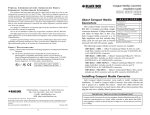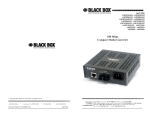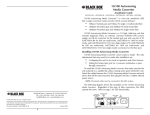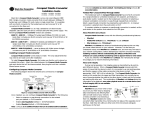Download Black Box LMC7001A-R4 network media converter
Transcript
Free 24-hour tech Support: 724-746-5500 blackbox.com © 2010. All rights reserved. Black Box Corporation. Compact Media Converters Small, inexpensive, easy to install—and each unit includes its own power supply. The converters you need for simple high-end copper to fiber conversion. 05/14/2010 #20400 1 of 5 Use a pair of media converters to connect two multimode fiber optic network segments via single-mode fiber. Features » Integrate copper with fiber seamlessly. » Compact 1U size saves space! » Multimode models send data 2 km (1.2 mi.). » Single-mode models send data 15 to 80 kilometers (9.3 to 49.7 mi.). » 10BASE-T/ThinNet version enables you to integrate your legacy coax infrastructure into your twisted-pair network. » With the single-strand models, you can convert 100- or 1000-Mbps copper wiring to 100- or 1000-Mbps single-mode fiber using a single strand that carries 1310- and 1550-nm wavelengths. » Integral universal power supply autosenses 95–240 VAC for use around the world. » No crossover cable needed on the UTP side! Auto MDI/ MDI-X detection figures out wiring type and adjusts to it automatically. » Front-panel LEDs indicate activity, and LinkFault Detection makes troubleshooting easy. » LinkLoss™ and FiberAlert™ notify you automatically of “silent failures” on the fiber side. » Converters feature externally accessible port settings. » Half- or full-duplex operation. » DIP switches for forcing modes of operation. » WARRANTY — 6 Years 05/14/2010 #20400 724-746-5500 10-/100-Mbps Autosensing Media Converter 10-/100-Mbps Autosensing Media Converter 10-Mbps NIC or 100-Mbps NIC Single-mode fiber 10/100 switch Multimode fiber Multimode fiber NOTE: This application will not work with a 10-/100-Mbps autosensing network interface card (NIC). OVERVIEW Save space. Only 1U high, these converters are the ideal choice when space is at a premium. They also feature internal power supplies so you don’t need to make space for bulky external transformers. And because the power supplies are autosensing 120–240 VAC, you can use these converters internationally. Port settings are externally accessible, and each port includes diagnostic LEDs. Twisted-pair ports feature a straight-through/crossover switch. The BNC port on the LMC009A-R4 features a termination switch. When faults occur, diagnostic LEDs alert you to location and type, so you can quickly isolate any breaks or problems on the copper or fiber segments. LinkLoss and FiberAlert notify you automatically of connection failures on the fiber side. You can enable or disable LinkLoss/FiberAlert with a DIP switch. What’s more, these converters really go the distance. Multimode models send data 2 km (1.2 mi.). Single-mode models send data 15 km to 60 kilometers (9.3 to 37.2 mi.). Powerful Plus models run up to 80 kilometers (49.7 mi.). Double your fiber capacity. With the single-strand models, you get all the benefits of Compact Media Converters, plus the ability to double your fiber capacity. Whether you already have fiber or you’re planning to install it, you can make better use of it with these converters. Ideal for ISPs and enterprise networks, these converters enable you to double your fiber capacity when converting 100BASE-TX wiring to fiber optic wiring in Ethernet networks. The converters compress two individual channels that contain transmit and receive wavelengths (1310 or 1550 nm) onto one single-mode, full-duplex fiber. The converters must be used in matched transmit and receive pairs. blackbox.com 2 of 5 BLACK BOX ® Technically Speaking Single-strand fiber WDM. Traditional fiber optic media converters perform a useful function but don’t really reduce the amount of cable needed to send data on a fiber segment. They still require two strands of glass to send transmit and receive signals for fiber media communications. Wouldn’t it be better to combine these two logical communication paths within one strand? That’s exactly what single-strand fiber conversion does. It compresses the transmit and receive wavelengths into one singlemode fiber strand. The conversion is done with Wavelength Division Multiplexing (WDM) technology. WDM technology increases the informationcarrying capacity of optical fiber by transmitting two or more signals simultaneously at different wavelengths on the same fiber. The way it usually works is that one unit transmits at 1550 nm and receives at 1310 nm. The other unit transmits at 1310 nm and receives at 1550 nm. The two wavelengths operate independently and don’t interfere with each other. Wavelength-sensitive filters are used at the receiving end to separate the wavelengths. This bidirectional traffic flow effectively converts a single fiber into a pair of “virtual fibers,” each driven independently at different wavelengths. 05/14/2010 #20400 724-746-5500 WDM on single-strand fiber is most often used for point-topoint links on a long-distance network. It’s also used to increase network capacity or relieve network congestion. Although the WDM used in media converters typically offers two channels on single-strand fiber at 10-, 100-, or 1000-Mbps speeds, WDM is a rapidly evolving techology that’s increasing the capacity of fiber infrastructure by leaps and bounds. Coarse wavelength-division multiplexing (CWDM) uses wavelengths between 1310 nm and 1610 nm and usually multiplexes signals across eight channels, although some versions support up to 16 channels. The relatively new 10GBASE-LX4 Ethernet standard achieves its 10-Gigabit speeds by using CWDM to divide the data stream into four separate 3.125-Gbps channels for transmission over fiber cable. Dense wavelength-division multiplexing (DWDM) uses the 1550-nm band and increases channel density even more. It can achieve as many as 64 channels on a single fiber strand. With DWDM it’s possible to achieve speeds of hundreds of Gbps across a single fiber. Its ability to handle vast amounts of traffic — even different kinds of traffic moving at different speeds — makes DWDM the technology of choice for metropolitan area networks. Companies that offer TV, Internet, and phone service on fiber use this technology. blackbox.com 3 of 5 BLACK BOX ® T e c h S P e cs LMC001A-R5 05/14/2010 #20400 724-746-5500 Approvals — UL®, cUL, CE, RoHS Fiber Cable Requirements — LMC7001A-R4–LMC7002A-R4: Multimode duplex, 850 nm; LMC7005A–LMC7006A: Multimode duplex, 1300 nm LMC7003A-R4–LMC7004A-R4, LMC7007A–LMC7008A: Single-mode duplex, 1310 nm; LMC7009A: Single-mode duplex, 1550 nm Full-Duplex Distance (Maximum) — LMC001A-R5–LMC004A-R5, LMC007A-R5–LMC008A-R5, LMC009A-R4: 10BASE-T link: 100 m (328 ft.); LMC001A-R5–LMC002A-R5, LHC001A-R4–LHC002A-R4, LHC009A-R3: Fiber link: 2 km (1.2 mi.); LMC003A-R5–LMC004A-R5: Fiber link: 10 km (6.2 mi.); LMC007A-R5–LMC008A-R5: Fiber link: 40 km (24.9 mi.); LMC010A–LMC011A: Fiber link: 80 km (49.7 mi.); LMC012A: Fiber link: 100 km (62.1 mi.); LMC009A-R4: 10BASE2 link: 185 m (607 ft.); LMC7001A-R4–LMC7002A-R4: 984.3 ft. (300 m); LMC7005A–LMC7006A: 1.2 mi. (2 km); LMC7003A-R4–LMC7004A-R4: 24.8 mi. (40 km); LMC7007A–LMC7009A: 49.7 mi. (80 km); LHC008A-R3–LHC009A-R3: Fiber link: 300 m (984.3 ft.); LHC001A-R4–LHC002A-R4, LHC005A-R4–LHC006A-R4: 100BASE-TX link: 100 m (328 ft.); LHC008A-R3–LHC009A-R3: 100BASE-TX link: 300 m (984.3 ft.); LHC005A-R4–LHC006A-R4: Fiber link: 40 km (24.9 mi.); LHC037A–LHC039A: Fiber link: 80 km (49.7 mi.) Heat Generated (Maximum) — 30 BTU/hour Standards — LMC001A-R5–LMC004A-R5, LMC007A-R5–LMC008A-R5, LMC009A-R4, LMC010A–LMC012A, LHC001A-R4–LHC002A-R4, LHC005A-R4– LHC005A-R4, LHC008A-R3, LHC009A-R3, LHC037A–LHC039A: IEEE 802.3: 10BASE-T, 10BASE-FL; LMC7001A-R4–LMC7002A-R4: IEEE 802.3: 10BASE-T, 10BASE-FL, 100BASE-TX, 100BASE-SX; LMC7005A–LMC7006A, LMC7003A-R4–LMC7004A-R4, LMC7007A–LMC7009A: IEEE 802.3u: IEEE 802.3: 10BASE-T, 10BASE-FL, 100BASE-TX, 100BASE-FX Wavelength — LMC001A-R5–LMC002A-R5: 850 nm multimode; LMC003A-R5–LMC004A-R5, LHC001A-R4–LHC002A-R4, LHC008A-R3–LHC009A-R3: 1300 nm multimode; LMC007A-R5–LMC008A-R5, LHC005A-R4–LHC006A-R4, LHC037A–LHC038A: 1300 nm single-mode; LHC039A: 1550 nm single-mode User Controls — LMC7001A-R4–LMC7004A-R4, LMC7005A–LMC7009A: (1) external 8-position DIP switch, (1) twisted-pair crossover/ pass-through button Connectors — LMC009A-R4: (1) RJ-45 (shielded), (1) BNC F; All others: (1) RJ-45 (shielded), (1) ST® or SC LMC7001A-R4, LMC7005A, LMC7003A-R4, LMC7007A: (1) RJ-45, (1) IEC 320 power connector, (1) pair of ST®; LMC7002A-R4, LMC7006A, LMC7004A-R4, LMC7008A–LMC7009A: (1) RJ-45, (1) IEC 320 power connector, (1) pair of SC Indicators — LMC001A-R5–LMC004A-R5, LMC007A-R5–LMC008A-R5, LHC008A-R3–LHC009A-R3, LHC001A-R4–LHC002A-R4, LHC005A-R4–LHC006A-R4, LHC037A–LHC039A: Fiber Receive, Twisted-Pair Link, Fiber Alert, Fiber Link; LMC009A-R4: Twisted-Pair Receive, Twisted-Pair Link, BNC Collision, BNC Receive LMC7001A-R4–LMC7004A-R4, LMC7005A–LMC7009A: (9) LEDs: (1) PWR: On when unit has power; Twisted-pair ports (TX): (1) Link; (1) Act; (1) 100: On when 100-Mbps data is detected; (1) LFD: On when Link Fault Detection is available (only in PNP/Transparent mode); (1) A: On when PNP/Transparent mode is enabled; Fiber ports (SX): (1) Link: On when link is established and all cables are connected; (1) Act: Blinks when data is detected; (1) 100: On when 100-Mbps data is detected Temperature — Operating: 32 to 104°F (0 to 40°C); Storage: 22 to 160°F (-5 to +71°C) Humidity Tolerance — 5 to 95%, noncondensing Power — LMC001A-R5–LMC004A-R5, LMC007A-R5–LMC008A-R5, LMC009A-R4, LHC008A-R3–LHC009A-R3, LHC037A–LHC039A: 110–240 VAC, 50–60 Hz, internal, autosensing; LHC001A-R4–LHC002A-R4, LHC005A-R4–LHC006A-R4: 95–240 VAC, 50–60 Hz, 0.1/0.5 A, internal, autosensing LMC7001A-R4–LMC7004A-R4, LMC7005A–LMC7009A: 100/240 VAC (±10%), 50/60 Hz, 0.1/0.05 A Size — 1.5"H x 4.7"W x 4.4"D (3.8 x 11.9 x 11.2 cm) Weight — 2 lb. (0.9 kg) blackbox.com 4 of 5 BLACK BOX ® NOTE: Single-strand models must be used in matched transmit and receive pairs. For example, to send your data 20 kilometers, order the LHC5129A-R3 and the LHC5130A-R3 together. Questions? Contact our FREE Tech Support. LMC009A-R4 LMC7001A-R4 Item Compact Media Converters 10BASE-T to 10BASE-FL Multimode 850-nm 2.km ST ® LMC001A-R5 SC LMC002A-R5 1300-nm 2.km ST LMC003A-R5 SC LMC004A-R5 Single-Mode Plus 1310-nm 40.km ST LMC007A-R5 SC LMC008A-R5 80.km ST LMC010A SC LMC011A 1550-nm 80.km SC LMC012A 10BASE-T to ThinNet 300.m LMC009A-R4 10BASE-T/100BASE-TX Autosensing to 100BASE-SX Duplex Multimode 850-nm 300 m ST LMC7001A-R4 SC LMC7002A-R4 10BASE-T/100BASE-TX Autosensing to 100BASE-FX Duplex 1300-nm 2.km ST LMC7005A SC LMC7006A Single-Mode Plus 1310-nm 40.km ST LMC7003A-R4 SC LMC7004A-R4 80.km ST LMC7007A SC LMC7008A 1550-nm 80.km SC LMC7009A 100BASE-TX to 100BASE-FX Duplex Multimode 850-nm 300 m ST LHC008A-R3 SC LHC009A-R3 1300-nm 2.km ST LHC001A-R4 SC LHC002A-R4 Code Item Compact Media Converters (Continued) 100BASE-TX to 100BASE-FX Duplex (Continued) Single-Mode Plus 1310-nm 40.km ST SC 80.km ST SC 1550-nm 80.km SC 100BASE-TX to 100BASE-BX Single-Strand Single-Mode (Use in matched pairs.) 1310-nm TX/1550-nm RX 20.km SC 1550-nm TX/1310-nm RX 20.km SC 1310-nm TX/1550-nm RX 40.km SC 1550-nm TX/1310-nm RX 40.km SC 1310-nm TX/1550-nm RX 60.km SC 1550-nm TX/1310-nm RX 60.km SC 1000BASE-TX to 1000BASE-SX Duplex Multimode 850-nm 300 m SC 1000BASE-TX to 1000BASE-LX Duplex Single-Mode 1310-nm 15.km SC 1310-nm 40.km SC 1550-nm 70.km SC 1000BASE-TX to 1000BASE-LX Single-Strand Single-Mode (Use in matched pairs.) 1310-nm TX/1550-nm RX 15.km SC 1550-nm TX/1310-nm RX 15.km SC 1310-nm TX/1550-nm RX 40.km SC 1550-nm TX/1310-nm RX 40.km SC Code LHC005A-R4 LHC006A-R4 LHC037A LHC038A LHC039A LHC5129A-R3 LHC5130A-R3 LHC5132A-R3 LHC5133A-R3 LHC5134A LHC5135A LGC5134A-R4 LGC5137A-R2 LGC5135A-R3 LGC5138A-R2 LGC5139A LGC5140A LGC5141A LGC5142A-R2 LHC5129A-R3 05/14/2010 #20400 724-746-5500 blackbox.com 5 of 5 BLACK BOX ®








